Next week marks once again the anniversary of the Tiananmen Massacre. US photographer Jeff Widener was in Beijing in 1989 when the violent suppression of the student protests was imminent. He managed to take a photo there that went down in history: He photographed the “Tank Man”. Fabian Peltsch spoke with Widener about how the iconic photo came to be and how he perceived the dramatic days in Beijing at the time.
The first passenger aircraft developed in China made its maiden commercial flight on Sunday. It took the C919 less than two hours to fly from Shanghai to Beijing. According to Beijing’s plans, the C919 is supposed to conquer the international market and compete with Airbus and Boeing. However, there are doubts about whether this plan will succeed.
Taicang, just over 50 kilometers from Shanghai, proudly calls itself the “home of German companies”. Almost 500 German SMEs have settled in Taicang’s industrial zone. However, political tensions are now overshadowing the success story. Fabian Kretschmer was on the ground amidst the timber-framed houses and fountains.

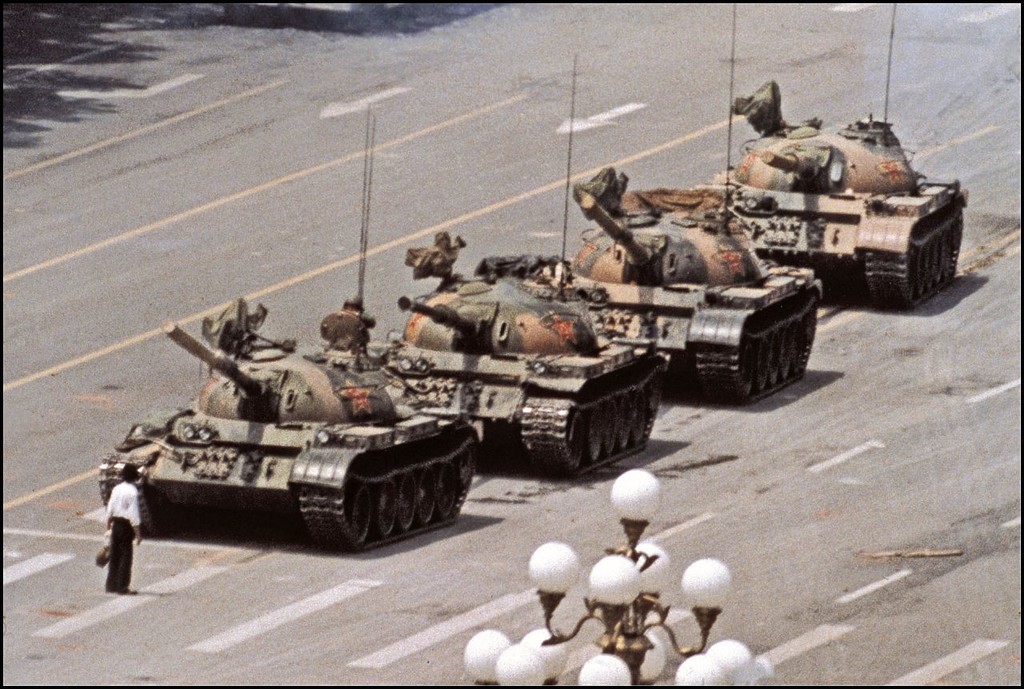
When did you realize that the picture you took of that man in front of the tank would become an iconic photo?
When I took the photo, I was actually angry that this guy, walking up to the tank with his two shopping bags. I thought: Oh no, this guy is gonna screw up my photo composition. I was sure he would be shot, so I kept my lens on him, but nothing happened. When I saw the photo for the first time after it was developed, I thought it was ok. It wasn’t that sharp. But when I came to the office the next day my editor came up to me and said: Jeff, you have received a couple of messages from New York. It was congratulation after congratulation from all over the world. Almost all the major papers in the UK had the photo on the front page. The president of AP congratulated me. I got a message from LIFE magazine, they also wanted to print it.
The photo opened a lot of doors for me over the years. But the realization, how iconic it really was, came years later. It must have been around the year 1999 when I browsed through some news sites. They had this section called ‘The Ten Most Memorable Photos of All Time’. And then there was mine among them. It hit me like a bolt of lightning. I had achieved something really great back then.
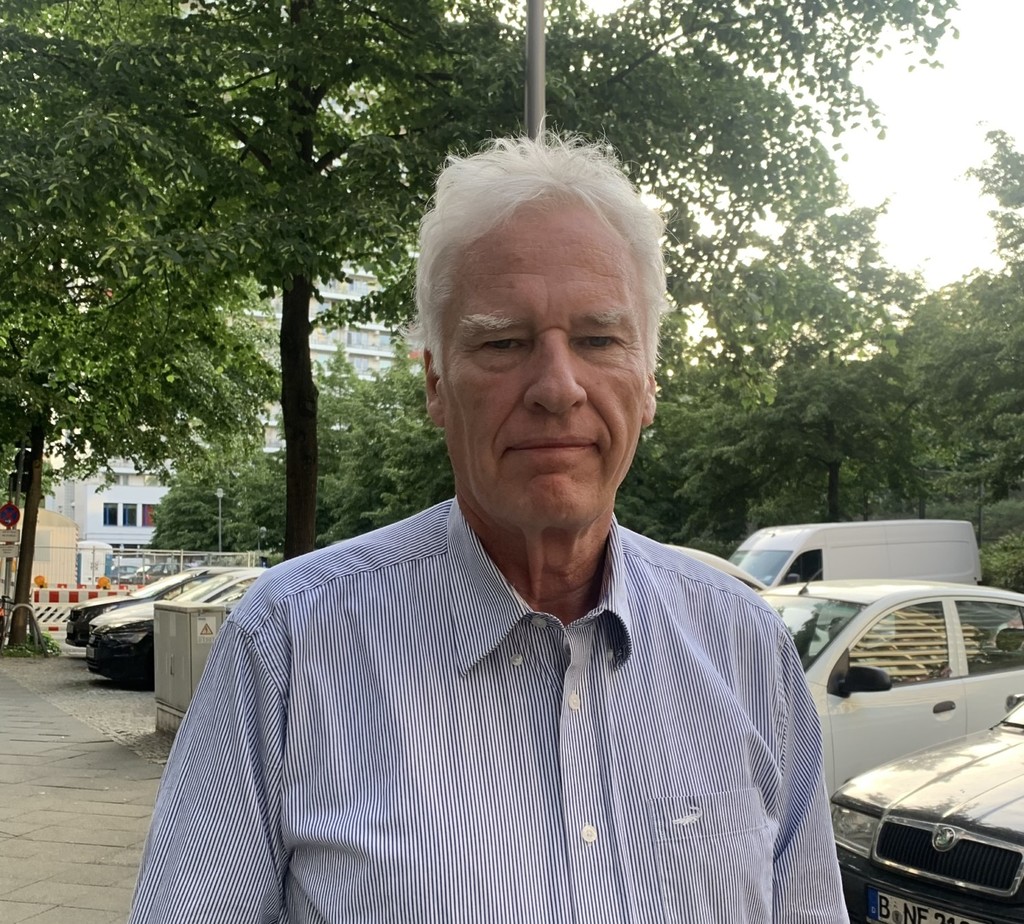
You have been in China just about two weeks before the situation between the protestors and the government became tense in the spring of 1989. How was the atmosphere on Tiananmen Square?
I went there every morning by sunrise and saw this sculpture of the goddess of democracy being constructed, facing the big Mao portrait! The atmosphere was happy, fantastic. It was well organized. People would line up to get food. They even had their own printing machine to update the people about what was happening on a daily basis. That was democracy, right there! I admired the courage of the students. But I also had the feeling that many of them didn’t understand the diplomacy that comes with democracy. There was a point where they had to back off. I mean, how much can you humiliate the Chinese government and the military? People even threw paint at the sacred portrait of Mao! It was just a matter of time until something would happen.
In my opinion, the student leaders should have sat down to come to a consensus of what they are going to do and what it was that they wanted to get out of this situation. There would have been a chance to regroup and do some serious diplomatic negotiations later. There was a lot of fighting and ego involved. Then the government overreacted.
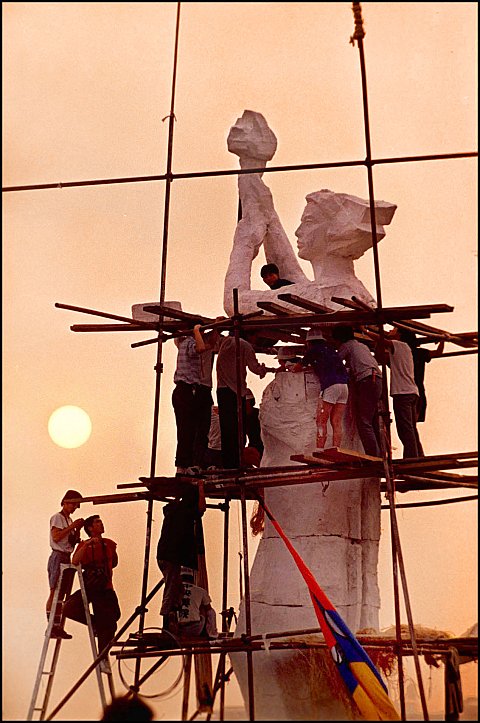
How was it to be in the middle of all of this when it escalated?
I remember it vividly. I had to pull the first night shift for Associated Press. I went out riding my bicycle with my reporter Dan Biers. I told him that I had a bad feeling about it. It was around midnight at Tiananmen Square when I saw the protestors coming out of the shadows with steel barricades. They put it into the middle of the road to stop the advance of any military vehicle.
We got off the main road around the Great Hall Of The People. Then I heard people shouting and saw them running. There was the loud noise of the barricades being hit by something big and something fast. Then I saw an APC with mounted machine guns being chased by protestors. I am a white-knuckle war photographer, but at this moment I got scared to death.
What happened then?
I decided to go back to the office. I had some great pictures already and I had them exclusive. So I picked up a bike and started to paddle to the other end of Chang’an Avenue to the diplomatic compound where our office was located. I saw a burning armored car and wanted to take a photo. I am very competitive after all. The adrenaline was running. I didn’t think. Suddenly, someone grabbed my camera strap and pulled my neck. Then I saw a mob around me pulling my cameras. They didn’t look like students. I thought they would tear me to shreds. I grabbed my American passport and held it over my head and yelled: “American, American!”
Then a guy who was obviously some kind of leader came to me and pointed to a dead soldier that I haven’t seen next to the burning armored car. He said: ‘You take photo, you tell world’. I took a picture and then – boom – a chunk of concrete hit me right in the face. I was seeing stars just like in the cartoons. Then another guy jumped out of the car, holding his hands up to surrender. His uniform looked pristine, meanwhile you could see the horror on his face. Then the mob moved in on him. And I went back on my bicycle. It wasn’t easy to get out of there. I had to lift my bike all the time over barricades.
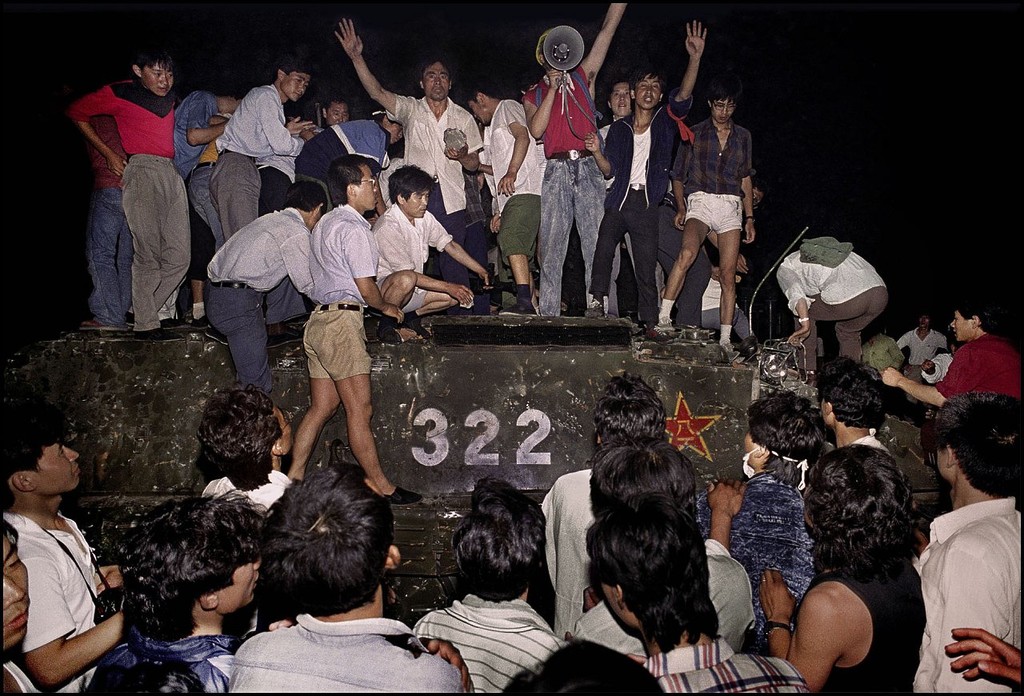
The famous ‘Tank Man’ photo was taken the next day. You had unexpected help from an exchange student…
The next day, when I went to the office, you could see all the debris and blood stains. The injury increased my fear factor. I felt vulnerable. Taking my bike and cycling back to Tiananmen took me to fight the biggest wall of fear I’ve ever imagined. I was heading to the Beijing Hotel because I knew I had a good overview from there. But I also knew there were secret police that used electric cattle prods on journalists who didn’t want to hand them their photo equipment. The lobby was dark, the lights were turned off.
But there was a kid, an American-looking guy. His name was Kirk, he was an exchange student. I walked up to him and pretended I knew him. I said, ‘Hey Joe, where have you been? I was looking for you.’ Then I whispered, I am from AP, can you let me into your room to take a picture?
He then took you to his balcony on the sixth floor.
He got me up on the roof and his balcony. I went to the edge and saw that the whole Tiananmen Square was full of tanks. I saw truckloads of soldiers passing by below and heard gunfire. Up there I noticed that I was running out of films. I asked Kirk if he could go down and try to find another film for me, because they knew he was a student, he was younger and had kinda long hair. And he really managed to get a film from a tourist.
Funnily, I got contacted by that tourist. He wrote me an email not long ago and said he didn’t want to give the film to Kirk. But Kirk was persistent. Later, he smuggled my films out of the hotel in his underwear.
So Kirk Martsen played a crucial role in the existence of the ‘Tank Man’ shot. Are you still in contact with him?
That’s a funny story. After what happened, we lost contact. I always wanted to thank him. One day I got an email from him, saying, hey Jeff, I don’t know if you remember me, I was the guy who smuggled your films out in my underpants. It blew my mind. We reconnected for a while. Planned to go on talk shows together.
Then he went back to China and started a business. And he completely cut our communication. He didn’t answer my emails anymore. The last thing I heard was that he became very successful. He didn’t want to upset the communists.
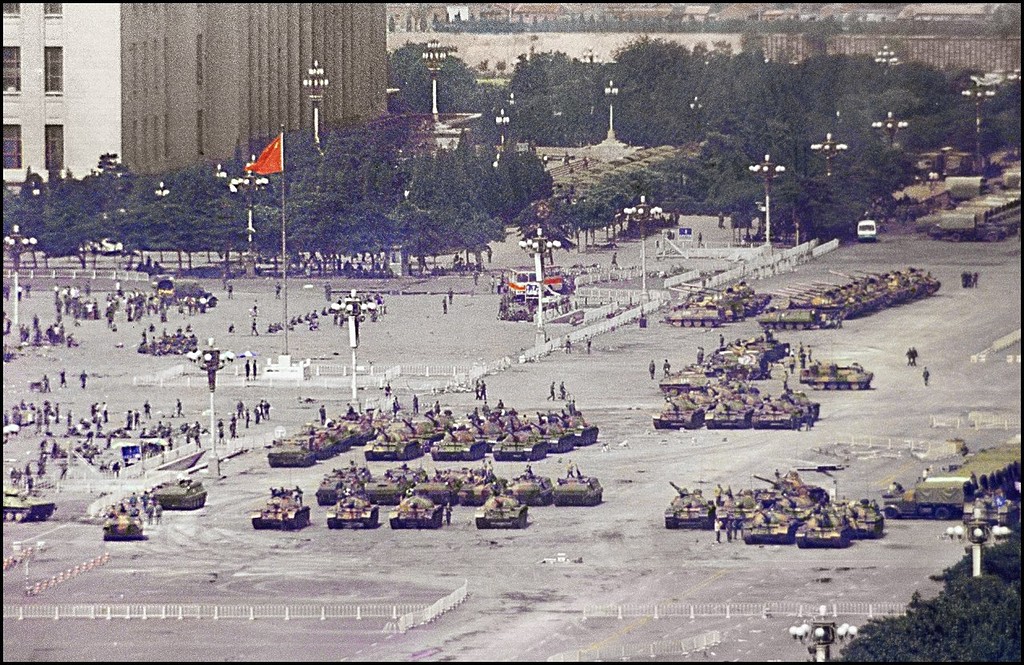
Have you ever had any problems with the Chinese government? Have they let you back into the country?
The government doesn’t like the photo for sure. But I actually never had a problem getting a visa in China. I am a journalist, that’s what I do. I am not a political activist, I am not calling for civil unrest. I have an opinion, yes, but I don’t pick up rocks to throw them at people. I believe journalism should be neutral and unbiased. I was in Beijing on an assignment back then. And I went back to China for work and for vacation. I even met my wife there in 2009, when the BBC shot an anniversary documentary.
On some occasions, I was followed. But I also remember a situation during the Olympics in Atlanta when a group of Chinese state journalists from Xinhua wanted to take pictures with me! They were going crazy when they found out it took that famous pic of the Tank Man. I think many have a love-hate relationship with that photo. The government tries to erase it. But I am sure this photo is going to be around for a long time. It’s part of history.
On 5 June 1989, Jeff Widener (66) captured a still unknown man standing in front of an approaching People’s Liberation Army tank during the Tiananmen Square protests for the Associated Press. Although other photographers also snapped the moment, Widener’s picture became a symbol of freedom and was nominated for the Pulitzer Prize in 1990. After a few years in Hamburg, the US photographer now lives in Mexico City with his German wife.
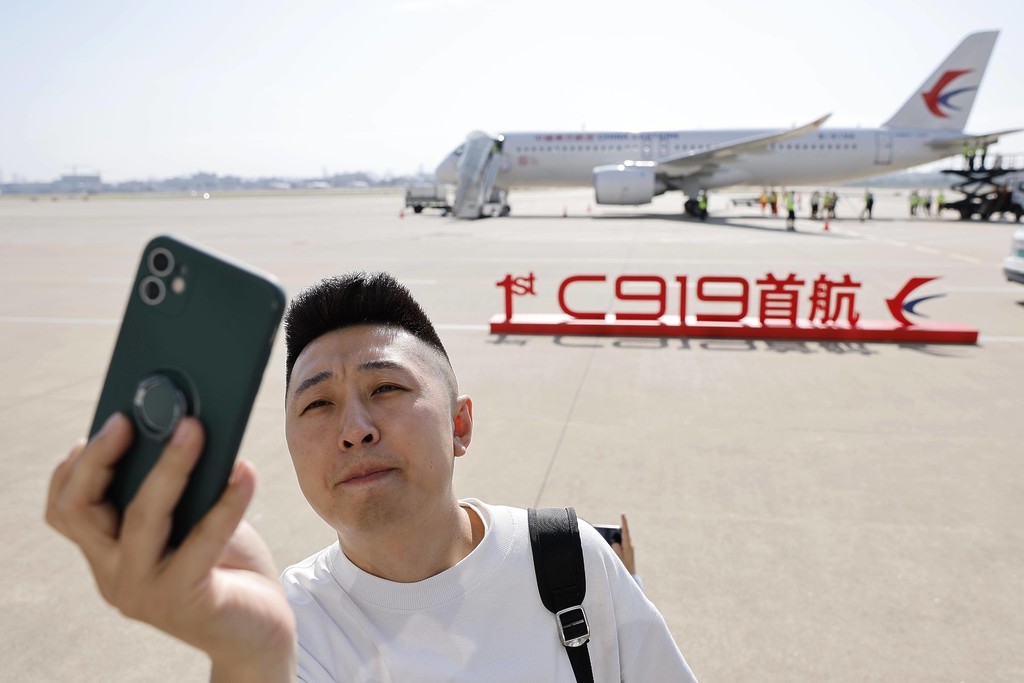
China’s first domestically developed passenger aircraft completed its maiden commercial flight on Sunday. The C919 aircraft built by the state-owned Chinese manufacturer Commercial Aircraft Corporation of China (Comac) made its two-hour flight from Shanghai Hongqiao to the capital’s airport in Beijing, accompanied by huge media hype.
The medium-haul aircraft, operated by state-backed China Eastern Airlines, landed “smoothly” in the capital 40 minutes before its scheduled arrival time, broadcaster CCTV reported. On board were 130 passengers, who were welcomed with a festive ceremony after landing. They received boarding passes specially designed as collector’s items in the red color of the national flag.
The commercial flight of the Comac aircraft represents both a milestone and a prestige project for China. With the C919, Beijing wants to become independent of Western technology, but in the long term, it also wants to break the duopoly of Boeing and Airbus. Asia, and China in particular, are important markets for both Europe’s Airbus and its US competitor Boeing, as demand for air travel is steadily increasing due to the region’s growing middle class.
According to the World Bank, China’s passenger air traffic has increased more than tenfold between 2000 and its peak in 2019, from 62 million to 660 million passengers. Boeing projects that around 8,600 new passenger aircraft will be needed in China alone by 2040. Airbus recently announced plans to double production capacity at its Tianjin plant.
The construction and development of the aircraft, which outwardly resembles the Airbus A320, presented the planners with significant challenges. Completion was postponed several times, and the original budget of eight billion euros was raised at least three times. The original goal of the state-owned company, founded in 2008, to put the aircraft into service in 2016 was widely missed.
The C919, which reaches a distance of around 5,633 kilometers, had already completed its actual maiden flight in 2017, but without passengers at the time. Further flight tests had become necessary. According to a Reuters report, cracks formed on the tailplane during the testing phase in 2020. The Civil Aviation Authority (CAAC) granted final approval in fall 2022.
Many of the C919’s components, including the engines and parts of the on-board electronics, are supplied by numerous suppliers from several countries, as is common with aircraft. A list published by the trade portal Airframer shows that of the 82 most important suppliers of the C919, more than half are from the US, just under a third from Europe, and only 17 percent from China. And of the main Chinese suppliers, half are joint ventures with foreign partners. So, according to experts, the aircraft can hardly be called ‘Made in China’ the government is striving for. On top of that, foreign companies have not provided their most up-to-date technology to Chinese aircraft manufacturers over concerns of passing on know-how.
Earlier state media reports stated that Comac plans to build and deliver 150 C919 aircraft annually over the next five years. The manufacturer claims to have already received over 1,200 orders for the C919, all from Chinese state-owned airlines. However, these are reportedly mainly letters of intent.
For the time being, the aircraft will not be certified outside China. Initially, the C919 is supposed to become a success story on the domestic market. On Monday, it entered service on China Eastern’s regular route between Shanghai and the southwestern city of Chengdu, CCTV reported.
In the next step, Comac plans to expand into the Asian market. Comac has already manufactured the ARJ21 short-haul aircraft, operated by Chinese airlines and Indonesia’s TransNusa. In cooperation with the Russian aviation company UAC, Comac is also planning the construction of the CR929 wide-body aircraft with two passenger aisles and a range of 12,000 kilometers. However, the original maiden flight scheduled for 2025 was corrected five years back due to numerous problems.
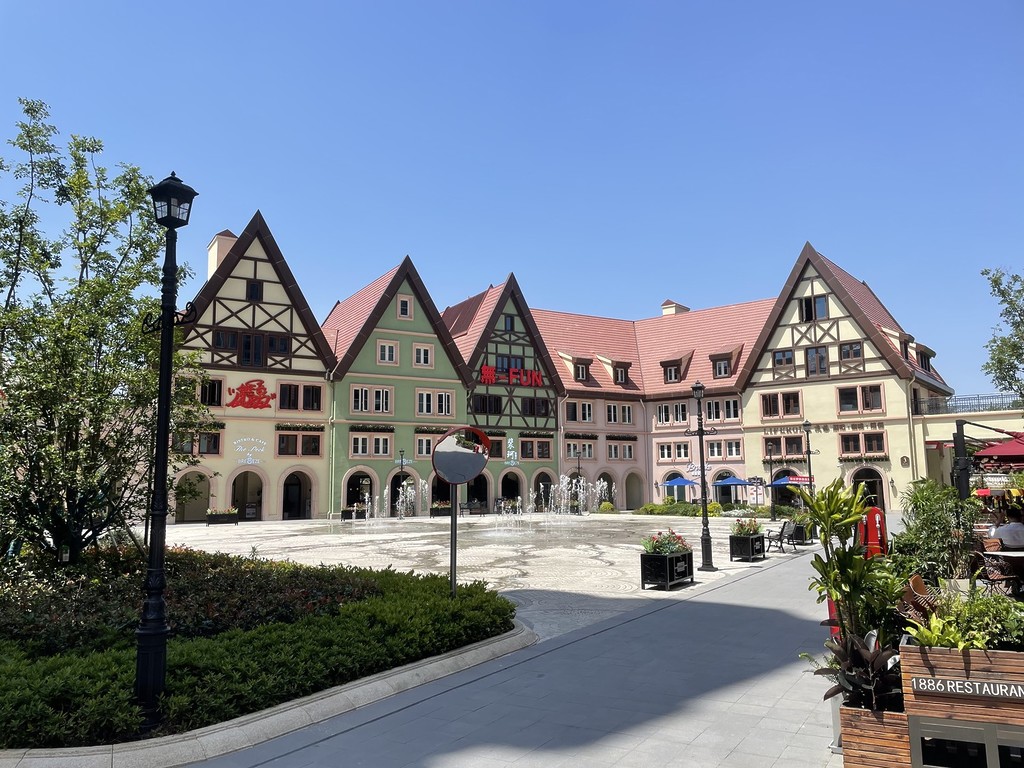
When the automotive supplier Kern-Liebers set up shop in Taicang, an hour’s drive north of Shanghai, the German company started with just six employees. Some 30 years later, Simon Veit, a shirt-sleeved executive type with a firm handshake, welcomes us in front of an ultra-modern production plant where around 800 employees work in an area the size of more than five football fields.
“Until about 2018, everything was moving at Chinese speed,” says regional manager Veit as he walks with long steps through the brightly lit factory corridors. Most recently, however, Veit says, problems in China piled up: New tax regulations, the Covid pandemic, and finally, a global chip shortage. “Since then, crisis mode has become the new normal.”
His words reflect the ambivalent attitude many entrepreneurs feel in Taicang. Kern-Liebers was the first medium-sized company to settle in the then newly founded industrial zone in 1993 – and thus unexpectedly gave the starting signal for a unique success story: Today, there are almost 500 German companies in the eastern Chinese satellite city, including many “hidden champions” such as the machine tool manufacturer Trumpf or the automotive supplier Schaeffler. Taicang’s locational advantage was obvious: wages were cheaper than in the big cities, yet the international financial and port city of Shanghai is only 50 kilometers away.
The fact that Taicang proudly calls itself “home to German companies” is reflected in the townscape: On the Rothenburg promenade, city authorities have created an imitation of a typical German old town with half-timbered houses and fountains. The adjacent pub, “Schindlers Tankstelle” serves pork knuckle with sauerkraut, and pretzels are available at the popular bakery “Brotecke.” And the “German Center Taicang” holds an Oktoberfest with beer and roast chicken every year.
The affinity of the Chinese to German culture has an economic root: The companies from faraway Europe brought new prosperity to Taicang, after all. Whereas the local population still only rode bicycles in the 1990s, the chessboard-like streets are now lined with import cars. People moved from old tenements to modern high-rise housing estates and now spend their spare time in spacious parks and neon-lit shopping centers. For a long time, Taicang and Germany seemed to be a never-ending success story.
But by now, little is left of the euphoria of bygone days in China’s “Little Swabia.” The draconian zero-Covid policy meant that only a third of the 3,000 Germans who once lived in Taicang have stayed since the beginning of the pandemic. Most of them are commuters who work in Taicang but live in Shanghai. The “German homeland” in China now exists mainly on paper: There are hardly any Germans left in the public cityscape and offices. Many of the “hidden champions” are now fully localized and do without expats from headquarters.
On top of that, political problems have turned China from a promising market into a problem candidate. Xi Jinping slowed down the growth engine of the People’s Republic with unpredictable regulatory waves and a return to ideological rule. And his aggressive threats against the democratic island state of Taiwan have long posed an existential risk for foreign companies: What happens if the People’s Liberation Army launches an invasion?
“Of course, we must ask ourselves how we should react in an emergency,” says Simon Veit von Kern-Liebers. At the same time, the executive emphasizes that little of the political tensions are noticeable in everyday life. Instead, they are more concerned about the staff situation: It has become difficult to find loyal and skilled employees and to keep them in the long term.
But it is obvious that international politics inevitably keeps forcing its way into everyday life. Only a few months ago, Hans-Jochem Steim, whose great-grandfather founded Kern-Liebers in 1888, traveled to Taicang for the 30th anniversary of German-Chinese cooperation. Steim, who is also an honorary citizen of the city, was supposed to give a speech, but it was quickly censored. The German entrepreneur was forced to remove a seemingly harmless passage that could possibly be interpreted as an allusion to Xi Jinping’s loyalty to Vladimir Putin: “Warlike confrontations do not help to improve living conditions. Only in mutual trust does the climate grow for the success we all seek. Aggression must not be a means of politics”. The paranoia of Chinese politics can hardly be conveyed more clearly.
However, anyone who asks about the new conditions in the impressive building of the city government only receives an embarrassed silence. On the 21st floor of the glass building, which offers a breathtaking view over the parks and apartment complexes of Taicang, no one wants to face any critical questions – neither about the new China policy of the German government, nor about the tensions with the US or even the criticism of Xi Jinping. Instead, the party cadres present themselves as emphatically pragmatic: “There is very good support for German companies that invest here,” says Thomas Zhang, for example, who is responsible for cooperation with medium-sized companies at the city government.
That may be true, after all, most German expats describe the local government as helpful and pragmatic. But it is just as obvious that a rougher wind has long been blowing in China under Xi Jinping – which could at some point also turn against their so far welcome German guest. Fabian Kretschmer
On Monday, Shanghai recorded the hottest May day in more than 100 years. At noon, the temperature at the Xujiahui underground station was 36.1 degrees Celsius, breaking a 100-year-old record for the highest temperature in May, AFP reported, citing a post on the official Weibo account of the metropolis’ weather service. The previous record was beaten by a full degree.
The temperature at the station had risen even further to 36.7 degrees Celsius later in the afternoon. This was a full degree above the old record of 35.7 °C, which, according to the weather service, had already been measured on four previous occasions: in 1876, 1903, 1915 and 2018. The apparent temperature in the city had even been displayed in several apps at over 40 degrees Celsius. Last year, several provinces already experienced weeks of extreme heat. In Shanghai, a heat record of 40.9 degrees was recorded. In Zhejiang, temperatures even climbed to 42 degrees. The neighboring coastal provinces of Jiangsu and Fujian also suffered from extreme heat.
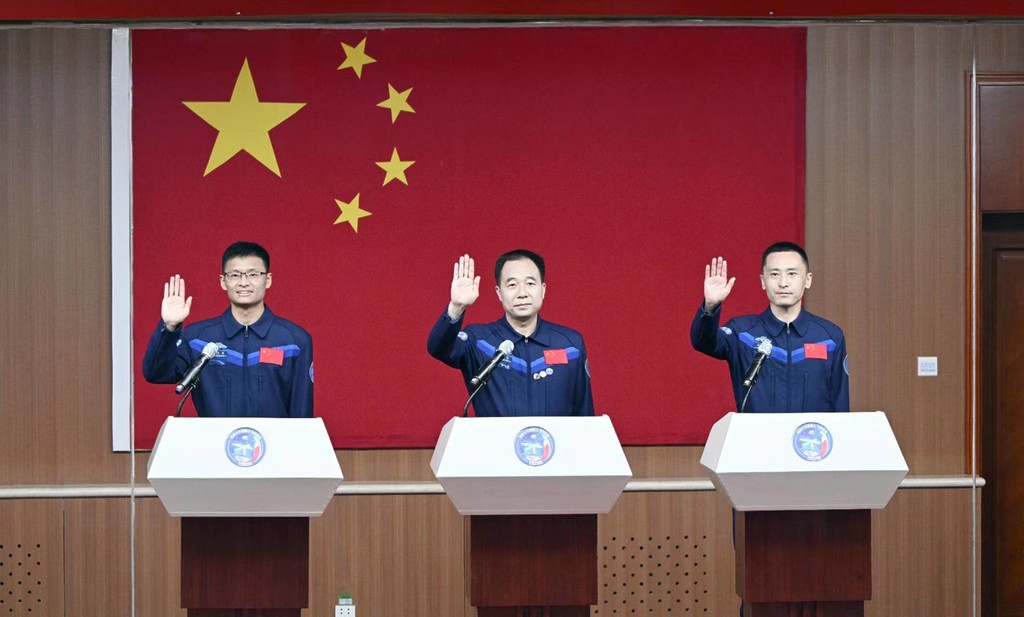
China plans to send its first civilian astronaut into space on Tuesday as part of a manned mission to the “Tiangong” space station: Gui Haichao, a payload expert, is scheduled to take off on Tuesday morning from the Jiuquan satellite launch center in northwest China on the “Shenzhou 16” spacecraft, China’s space agency announced on Monday. Gui will be accompanied by taikonauts Jing Haipeng and Zhu Yangzhu, both members of the People’s Liberation Army. Their mission in space is expected to take about five months.
Among other things, Gui is to carry out maintenance and repair equipment for scientific experiments on the space station. The mission’s leader, Jing, is the first Chinese astronaut to go into space for the fourth time. ari
Hong Kong has denied the arrest of a Uyghur scientist. Abuduwaili Abudureheman went missing after arriving in the city earlier this month, according to human rights activists. Hong Kong authorities stated there was no record of Abudureheman arriving in the territory or being denied entry, BBC reported on Monday. Abudureheman’s acquaintances told human rights organization Amnesty International that he had contacted them via text on 10 May, saying Hong Kong police had questioned him at the airport. He has not been heard from since, his friends told Amnesty International. The human rights organization called on Hong Kong to reveal Abudureheman’s whereabouts. However, the government insisted that this demand was tantamount to defamation, which was “groundless and unfounded.” Abudureheman was born in Xinjiang and has lived in South Korea for several years. According to Amnesty International, he has been on a Beijing “watch list.” ari
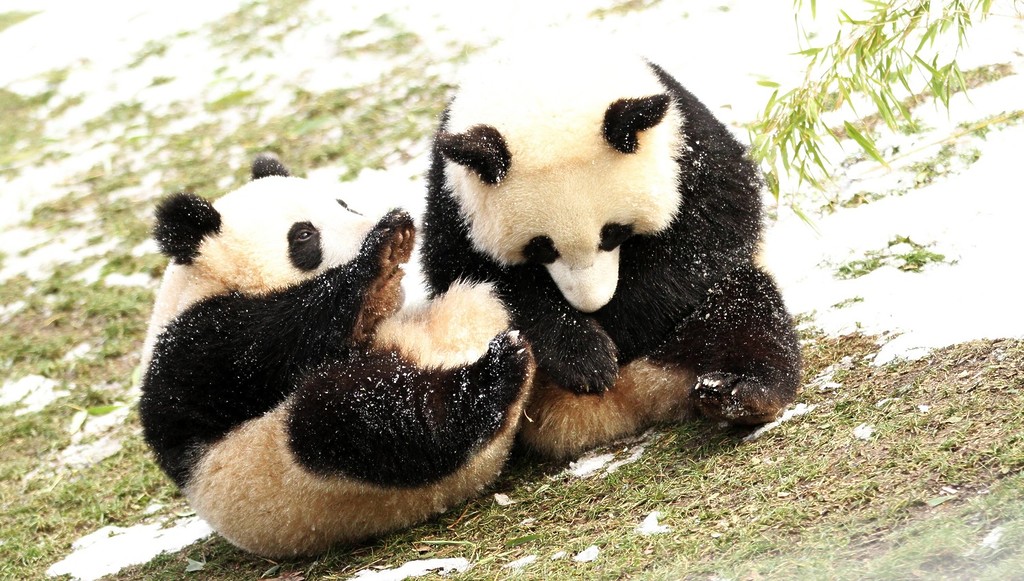
The panda twins Pit and Paule will most likely leave the Berlin Zoo this fall and be transported to China. This was reported to the Tagesspiegel podcast “Berliner & Pfannkuchen.” The animals’ parents, Meng Meng and Jiao Qing, had been received by the Berlin Zoo in 2017 as a long-term loan of 15 years. In 2019, they gave birth to the two cubs. The return was contractually stipulated.
All pandas in zoos around the world come from China. This is also known as panda diplomacy. Beijing lends the animals mainly to countries with which it wants to maintain good business and relations. Just in April, Ya Ya, the panda living in the United States, returned to China after 20 years. China’s state press and social media sharply criticized the Memphis Zoo for allegedly not properly caring for the animal, which suffered from a skin disease. Another panda had died at the Memphis Zoo shortly before. fpe
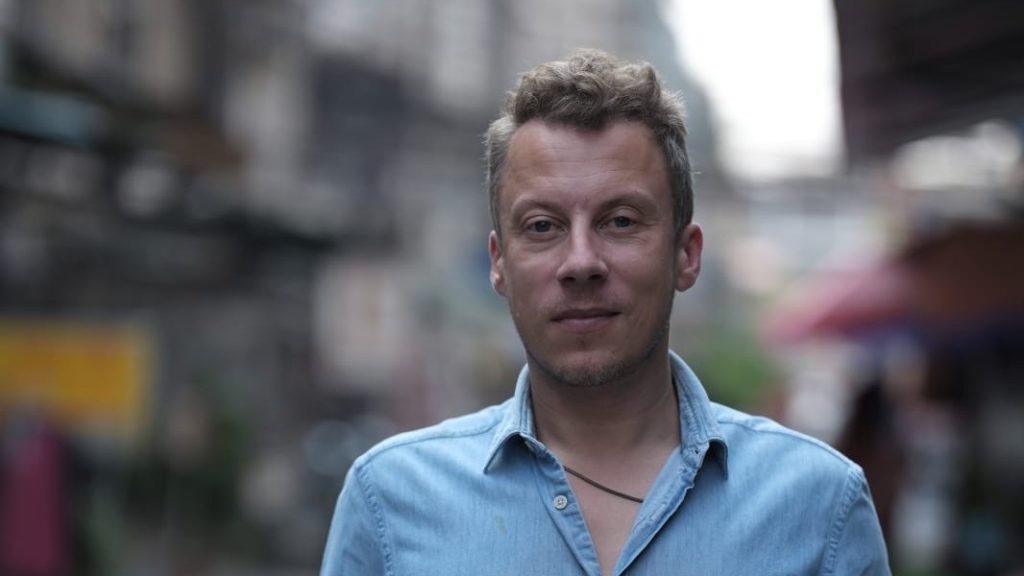
The African country of Zambia is not necessarily considered a “hotspot” by international donors. That is why Lusaka was all the more delighted to finally receive infrastructure loans from Beijing. In the past ten years, China has provided the country with several billion US dollars in loans. Zambia used the money to build an international airport, two sports stadiums and a hospital. A hydroelectric power plant near the capital Lusaka was also recently opened. But now Zambia is facing payment difficulties, and how these are resolved has implications for the global financial architecture and how it adapts to the changing realities of the 21st century.
Here, the American-Western dominated International Monetary Fund is pitted against Beijing, which has become the world’s largest creditor in recent years. And it is not only the African country of Zambia that is affected. A few weeks ago, the IMF, the World Bank and representatives of Beijing discussed how to solve the problem. However, no result was reached.
According to the IMF, 21 countries are currently facing “insolvency” or are having problems repaying their debts: from Egypt to Pakistan, from Sri Lanka to Laos. There is even mention of the biggest debt crisis in history, if the number of people affected is taken as a criterion – around 700 million. How it could come to this is not only due to the New Silk Road, but mainly because of it.
Ten years ago, China’s President Xi Jinping gave a momentous speech in the Kazakh capital Astana, which is considered the starting signal for the project, also known as the Belt and Road Initiative. In the following years, the Chinese government flooded emerging countries, particularly with billions of US dollars to finance infrastructure projects in the respective states. Among other things, this resulted in a rail line connecting the Chinese metropolis of Chongqing with the German city of Duisburg.
But above all, Beijing constructed railroads, roads and ports in Africa and Asia to transport raw materials to China. Pipelines, airports and highways are also among the projects. The pattern has always been the same: Beijing grants billion dollars loans for such a project, with the condition that Chinese companies are contracted to do the work and Chinese materials are procured. Ideally, the project generates a profit that the country can use to repay its loan. But this happens less and less frequently. The port of Hambantota in Sri Lanka made headlines a few years ago. When the island nation on the southern tip of India could no longer service its loan, Beijing unceremoniously “leased” the port for the next 99 years. Sri Lanka is an extreme example, but more and more countries on the “New Silk Road” are facing payment difficulties.
And this is by no means Beijing’s problem alone. A sovereign default by a single country not only negatively affects the largest creditor, but can trigger a cascade of bankruptcies and bring nations to the brink of civil war.
For a long time, the problem simmered beneath the surface. It was not until the sharp interest rate hikes by the US Federal Reserve, which began about a year ago, that financing costs increased worldwide. Added to this are the high energy prices burdening numerous countries’ budgets. Since most countries in the global South rely on energy imports in the form of oil and gas, deficits ballooned.
Multilateral cooperation would be needed to avert a global debt crisis. But Beijing refuses this, and sees the IMF as a Western power vehicle, since the United States has the most voting rights in the organization. Since its founding in 1944, the organization has lent about 700 billion US dollars to 150 countries. That is most likely much less than China has distributed in the past decade. But here lies another problem: No one, and probably not even the Chinese government itself, knows precisely how much money has been lent and on what terms. Although a study on AIData in 2021 concluded that China’s claims amount to at least 840 billion dollars. Of this amount, around 385 billion is “hidden debt.”
Over the past 65 years, the “Paris Club” has usually sought multilateral solutions. The informal body creates a framework in which indebted countries can reach an agreement with their creditors. But China never wanted to join the body, despite invitations. The consequences are now apparent: The IMF and Western countries only want to cancel debts or step in with emergency loans if Beijing cooperates; otherwise, the money would go more or less directly into the pockets of China’s creditors. The country’s new responsibility as a global lender is being appealed to. “We’ve worked very hard to get the Chinese leadership to recognize that with more wealth comes more responsibility,” Kristina Georgieva, who has headed the IMF since 2019, said recently. “They’ve had three years and the arguments have gotten increasingly ridiculous.”
China, on the other hand, is insisting on bilateral solutions such as follow-up loans and debt rescheduling. This is probably also due to Beijing’s geopolitical program of expanding its influence in the countries of the Global South.
Currently, Beijing and the IMF find themselves in a kind of chicken game, with two parties racing toward a cliff. Whoever turns first loses. The ones who suffer in this case are the indebted countries. Sri Lanka, which has already had to give a port to Beijing as “collateral,” has again been in payment difficulties since last summer and is experiencing one of its worst economic crises.
The text is a translation of a slightly modified excerpt from the book “Die dreckige Seidenstraße – Wie Chinas Wirtschaftspolitik weltweit Staaten und Demokratien untergraben” (The Dirty Silk Road – How China’s Economic Policies Are Undermining States and Democracies Around the World) by Philipp Mattheis, published by Gold-Mann-Verlag on May 24.
Anthony Zhao will be Rolls-Royce’s new Regional Director for Greater China. For the past seven years, Zhao has served as Head of Sales for BMW Brilliance Automotive. He replaces Leon Li, who is leaving the company to pursue new challenges.
Florian Biela has been Deputy Director Project Engineering for Uhlmann China, based in Shanghai, since May. The German company manufactures industrial machinery. Biela was previously Project Manager for Heuft Systemtechnik, also in Shanghai.
Is something changing in your organization? Let us know at heads@table.media!
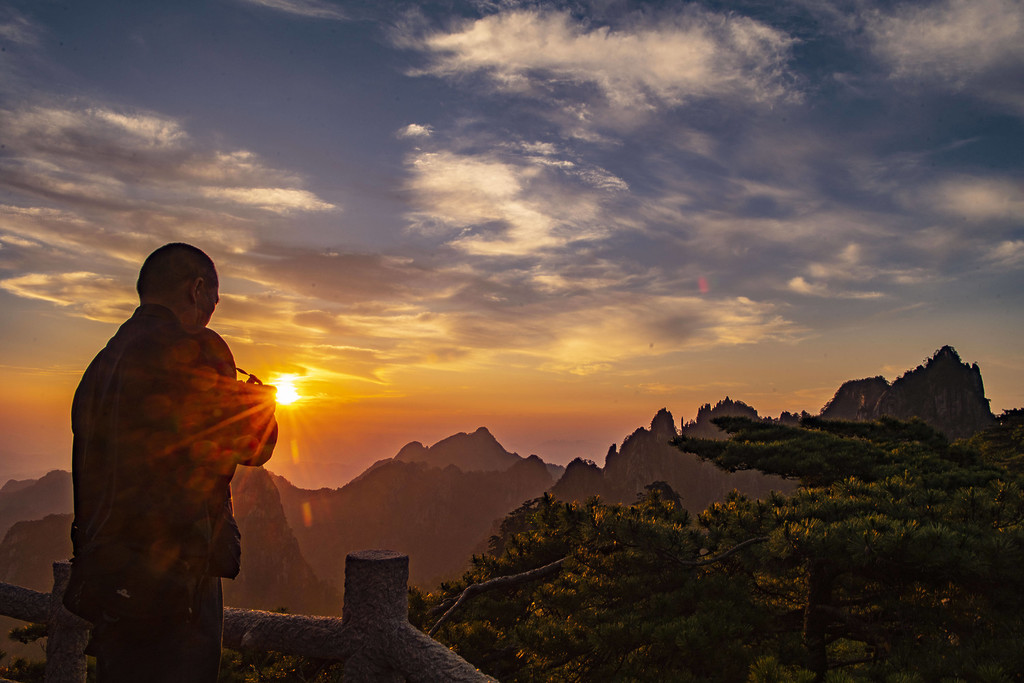
The karstic peaks of Huangshan in the eastern Chinese province of Anhui offer perfect photo spots. This tourist even got out of bed extra early to photograph the sunrise.
Next week marks once again the anniversary of the Tiananmen Massacre. US photographer Jeff Widener was in Beijing in 1989 when the violent suppression of the student protests was imminent. He managed to take a photo there that went down in history: He photographed the “Tank Man”. Fabian Peltsch spoke with Widener about how the iconic photo came to be and how he perceived the dramatic days in Beijing at the time.
The first passenger aircraft developed in China made its maiden commercial flight on Sunday. It took the C919 less than two hours to fly from Shanghai to Beijing. According to Beijing’s plans, the C919 is supposed to conquer the international market and compete with Airbus and Boeing. However, there are doubts about whether this plan will succeed.
Taicang, just over 50 kilometers from Shanghai, proudly calls itself the “home of German companies”. Almost 500 German SMEs have settled in Taicang’s industrial zone. However, political tensions are now overshadowing the success story. Fabian Kretschmer was on the ground amidst the timber-framed houses and fountains.


When did you realize that the picture you took of that man in front of the tank would become an iconic photo?
When I took the photo, I was actually angry that this guy, walking up to the tank with his two shopping bags. I thought: Oh no, this guy is gonna screw up my photo composition. I was sure he would be shot, so I kept my lens on him, but nothing happened. When I saw the photo for the first time after it was developed, I thought it was ok. It wasn’t that sharp. But when I came to the office the next day my editor came up to me and said: Jeff, you have received a couple of messages from New York. It was congratulation after congratulation from all over the world. Almost all the major papers in the UK had the photo on the front page. The president of AP congratulated me. I got a message from LIFE magazine, they also wanted to print it.
The photo opened a lot of doors for me over the years. But the realization, how iconic it really was, came years later. It must have been around the year 1999 when I browsed through some news sites. They had this section called ‘The Ten Most Memorable Photos of All Time’. And then there was mine among them. It hit me like a bolt of lightning. I had achieved something really great back then.

You have been in China just about two weeks before the situation between the protestors and the government became tense in the spring of 1989. How was the atmosphere on Tiananmen Square?
I went there every morning by sunrise and saw this sculpture of the goddess of democracy being constructed, facing the big Mao portrait! The atmosphere was happy, fantastic. It was well organized. People would line up to get food. They even had their own printing machine to update the people about what was happening on a daily basis. That was democracy, right there! I admired the courage of the students. But I also had the feeling that many of them didn’t understand the diplomacy that comes with democracy. There was a point where they had to back off. I mean, how much can you humiliate the Chinese government and the military? People even threw paint at the sacred portrait of Mao! It was just a matter of time until something would happen.
In my opinion, the student leaders should have sat down to come to a consensus of what they are going to do and what it was that they wanted to get out of this situation. There would have been a chance to regroup and do some serious diplomatic negotiations later. There was a lot of fighting and ego involved. Then the government overreacted.

How was it to be in the middle of all of this when it escalated?
I remember it vividly. I had to pull the first night shift for Associated Press. I went out riding my bicycle with my reporter Dan Biers. I told him that I had a bad feeling about it. It was around midnight at Tiananmen Square when I saw the protestors coming out of the shadows with steel barricades. They put it into the middle of the road to stop the advance of any military vehicle.
We got off the main road around the Great Hall Of The People. Then I heard people shouting and saw them running. There was the loud noise of the barricades being hit by something big and something fast. Then I saw an APC with mounted machine guns being chased by protestors. I am a white-knuckle war photographer, but at this moment I got scared to death.
What happened then?
I decided to go back to the office. I had some great pictures already and I had them exclusive. So I picked up a bike and started to paddle to the other end of Chang’an Avenue to the diplomatic compound where our office was located. I saw a burning armored car and wanted to take a photo. I am very competitive after all. The adrenaline was running. I didn’t think. Suddenly, someone grabbed my camera strap and pulled my neck. Then I saw a mob around me pulling my cameras. They didn’t look like students. I thought they would tear me to shreds. I grabbed my American passport and held it over my head and yelled: “American, American!”
Then a guy who was obviously some kind of leader came to me and pointed to a dead soldier that I haven’t seen next to the burning armored car. He said: ‘You take photo, you tell world’. I took a picture and then – boom – a chunk of concrete hit me right in the face. I was seeing stars just like in the cartoons. Then another guy jumped out of the car, holding his hands up to surrender. His uniform looked pristine, meanwhile you could see the horror on his face. Then the mob moved in on him. And I went back on my bicycle. It wasn’t easy to get out of there. I had to lift my bike all the time over barricades.

The famous ‘Tank Man’ photo was taken the next day. You had unexpected help from an exchange student…
The next day, when I went to the office, you could see all the debris and blood stains. The injury increased my fear factor. I felt vulnerable. Taking my bike and cycling back to Tiananmen took me to fight the biggest wall of fear I’ve ever imagined. I was heading to the Beijing Hotel because I knew I had a good overview from there. But I also knew there were secret police that used electric cattle prods on journalists who didn’t want to hand them their photo equipment. The lobby was dark, the lights were turned off.
But there was a kid, an American-looking guy. His name was Kirk, he was an exchange student. I walked up to him and pretended I knew him. I said, ‘Hey Joe, where have you been? I was looking for you.’ Then I whispered, I am from AP, can you let me into your room to take a picture?
He then took you to his balcony on the sixth floor.
He got me up on the roof and his balcony. I went to the edge and saw that the whole Tiananmen Square was full of tanks. I saw truckloads of soldiers passing by below and heard gunfire. Up there I noticed that I was running out of films. I asked Kirk if he could go down and try to find another film for me, because they knew he was a student, he was younger and had kinda long hair. And he really managed to get a film from a tourist.
Funnily, I got contacted by that tourist. He wrote me an email not long ago and said he didn’t want to give the film to Kirk. But Kirk was persistent. Later, he smuggled my films out of the hotel in his underwear.
So Kirk Martsen played a crucial role in the existence of the ‘Tank Man’ shot. Are you still in contact with him?
That’s a funny story. After what happened, we lost contact. I always wanted to thank him. One day I got an email from him, saying, hey Jeff, I don’t know if you remember me, I was the guy who smuggled your films out in my underpants. It blew my mind. We reconnected for a while. Planned to go on talk shows together.
Then he went back to China and started a business. And he completely cut our communication. He didn’t answer my emails anymore. The last thing I heard was that he became very successful. He didn’t want to upset the communists.

Have you ever had any problems with the Chinese government? Have they let you back into the country?
The government doesn’t like the photo for sure. But I actually never had a problem getting a visa in China. I am a journalist, that’s what I do. I am not a political activist, I am not calling for civil unrest. I have an opinion, yes, but I don’t pick up rocks to throw them at people. I believe journalism should be neutral and unbiased. I was in Beijing on an assignment back then. And I went back to China for work and for vacation. I even met my wife there in 2009, when the BBC shot an anniversary documentary.
On some occasions, I was followed. But I also remember a situation during the Olympics in Atlanta when a group of Chinese state journalists from Xinhua wanted to take pictures with me! They were going crazy when they found out it took that famous pic of the Tank Man. I think many have a love-hate relationship with that photo. The government tries to erase it. But I am sure this photo is going to be around for a long time. It’s part of history.
On 5 June 1989, Jeff Widener (66) captured a still unknown man standing in front of an approaching People’s Liberation Army tank during the Tiananmen Square protests for the Associated Press. Although other photographers also snapped the moment, Widener’s picture became a symbol of freedom and was nominated for the Pulitzer Prize in 1990. After a few years in Hamburg, the US photographer now lives in Mexico City with his German wife.

China’s first domestically developed passenger aircraft completed its maiden commercial flight on Sunday. The C919 aircraft built by the state-owned Chinese manufacturer Commercial Aircraft Corporation of China (Comac) made its two-hour flight from Shanghai Hongqiao to the capital’s airport in Beijing, accompanied by huge media hype.
The medium-haul aircraft, operated by state-backed China Eastern Airlines, landed “smoothly” in the capital 40 minutes before its scheduled arrival time, broadcaster CCTV reported. On board were 130 passengers, who were welcomed with a festive ceremony after landing. They received boarding passes specially designed as collector’s items in the red color of the national flag.
The commercial flight of the Comac aircraft represents both a milestone and a prestige project for China. With the C919, Beijing wants to become independent of Western technology, but in the long term, it also wants to break the duopoly of Boeing and Airbus. Asia, and China in particular, are important markets for both Europe’s Airbus and its US competitor Boeing, as demand for air travel is steadily increasing due to the region’s growing middle class.
According to the World Bank, China’s passenger air traffic has increased more than tenfold between 2000 and its peak in 2019, from 62 million to 660 million passengers. Boeing projects that around 8,600 new passenger aircraft will be needed in China alone by 2040. Airbus recently announced plans to double production capacity at its Tianjin plant.
The construction and development of the aircraft, which outwardly resembles the Airbus A320, presented the planners with significant challenges. Completion was postponed several times, and the original budget of eight billion euros was raised at least three times. The original goal of the state-owned company, founded in 2008, to put the aircraft into service in 2016 was widely missed.
The C919, which reaches a distance of around 5,633 kilometers, had already completed its actual maiden flight in 2017, but without passengers at the time. Further flight tests had become necessary. According to a Reuters report, cracks formed on the tailplane during the testing phase in 2020. The Civil Aviation Authority (CAAC) granted final approval in fall 2022.
Many of the C919’s components, including the engines and parts of the on-board electronics, are supplied by numerous suppliers from several countries, as is common with aircraft. A list published by the trade portal Airframer shows that of the 82 most important suppliers of the C919, more than half are from the US, just under a third from Europe, and only 17 percent from China. And of the main Chinese suppliers, half are joint ventures with foreign partners. So, according to experts, the aircraft can hardly be called ‘Made in China’ the government is striving for. On top of that, foreign companies have not provided their most up-to-date technology to Chinese aircraft manufacturers over concerns of passing on know-how.
Earlier state media reports stated that Comac plans to build and deliver 150 C919 aircraft annually over the next five years. The manufacturer claims to have already received over 1,200 orders for the C919, all from Chinese state-owned airlines. However, these are reportedly mainly letters of intent.
For the time being, the aircraft will not be certified outside China. Initially, the C919 is supposed to become a success story on the domestic market. On Monday, it entered service on China Eastern’s regular route between Shanghai and the southwestern city of Chengdu, CCTV reported.
In the next step, Comac plans to expand into the Asian market. Comac has already manufactured the ARJ21 short-haul aircraft, operated by Chinese airlines and Indonesia’s TransNusa. In cooperation with the Russian aviation company UAC, Comac is also planning the construction of the CR929 wide-body aircraft with two passenger aisles and a range of 12,000 kilometers. However, the original maiden flight scheduled for 2025 was corrected five years back due to numerous problems.

When the automotive supplier Kern-Liebers set up shop in Taicang, an hour’s drive north of Shanghai, the German company started with just six employees. Some 30 years later, Simon Veit, a shirt-sleeved executive type with a firm handshake, welcomes us in front of an ultra-modern production plant where around 800 employees work in an area the size of more than five football fields.
“Until about 2018, everything was moving at Chinese speed,” says regional manager Veit as he walks with long steps through the brightly lit factory corridors. Most recently, however, Veit says, problems in China piled up: New tax regulations, the Covid pandemic, and finally, a global chip shortage. “Since then, crisis mode has become the new normal.”
His words reflect the ambivalent attitude many entrepreneurs feel in Taicang. Kern-Liebers was the first medium-sized company to settle in the then newly founded industrial zone in 1993 – and thus unexpectedly gave the starting signal for a unique success story: Today, there are almost 500 German companies in the eastern Chinese satellite city, including many “hidden champions” such as the machine tool manufacturer Trumpf or the automotive supplier Schaeffler. Taicang’s locational advantage was obvious: wages were cheaper than in the big cities, yet the international financial and port city of Shanghai is only 50 kilometers away.
The fact that Taicang proudly calls itself “home to German companies” is reflected in the townscape: On the Rothenburg promenade, city authorities have created an imitation of a typical German old town with half-timbered houses and fountains. The adjacent pub, “Schindlers Tankstelle” serves pork knuckle with sauerkraut, and pretzels are available at the popular bakery “Brotecke.” And the “German Center Taicang” holds an Oktoberfest with beer and roast chicken every year.
The affinity of the Chinese to German culture has an economic root: The companies from faraway Europe brought new prosperity to Taicang, after all. Whereas the local population still only rode bicycles in the 1990s, the chessboard-like streets are now lined with import cars. People moved from old tenements to modern high-rise housing estates and now spend their spare time in spacious parks and neon-lit shopping centers. For a long time, Taicang and Germany seemed to be a never-ending success story.
But by now, little is left of the euphoria of bygone days in China’s “Little Swabia.” The draconian zero-Covid policy meant that only a third of the 3,000 Germans who once lived in Taicang have stayed since the beginning of the pandemic. Most of them are commuters who work in Taicang but live in Shanghai. The “German homeland” in China now exists mainly on paper: There are hardly any Germans left in the public cityscape and offices. Many of the “hidden champions” are now fully localized and do without expats from headquarters.
On top of that, political problems have turned China from a promising market into a problem candidate. Xi Jinping slowed down the growth engine of the People’s Republic with unpredictable regulatory waves and a return to ideological rule. And his aggressive threats against the democratic island state of Taiwan have long posed an existential risk for foreign companies: What happens if the People’s Liberation Army launches an invasion?
“Of course, we must ask ourselves how we should react in an emergency,” says Simon Veit von Kern-Liebers. At the same time, the executive emphasizes that little of the political tensions are noticeable in everyday life. Instead, they are more concerned about the staff situation: It has become difficult to find loyal and skilled employees and to keep them in the long term.
But it is obvious that international politics inevitably keeps forcing its way into everyday life. Only a few months ago, Hans-Jochem Steim, whose great-grandfather founded Kern-Liebers in 1888, traveled to Taicang for the 30th anniversary of German-Chinese cooperation. Steim, who is also an honorary citizen of the city, was supposed to give a speech, but it was quickly censored. The German entrepreneur was forced to remove a seemingly harmless passage that could possibly be interpreted as an allusion to Xi Jinping’s loyalty to Vladimir Putin: “Warlike confrontations do not help to improve living conditions. Only in mutual trust does the climate grow for the success we all seek. Aggression must not be a means of politics”. The paranoia of Chinese politics can hardly be conveyed more clearly.
However, anyone who asks about the new conditions in the impressive building of the city government only receives an embarrassed silence. On the 21st floor of the glass building, which offers a breathtaking view over the parks and apartment complexes of Taicang, no one wants to face any critical questions – neither about the new China policy of the German government, nor about the tensions with the US or even the criticism of Xi Jinping. Instead, the party cadres present themselves as emphatically pragmatic: “There is very good support for German companies that invest here,” says Thomas Zhang, for example, who is responsible for cooperation with medium-sized companies at the city government.
That may be true, after all, most German expats describe the local government as helpful and pragmatic. But it is just as obvious that a rougher wind has long been blowing in China under Xi Jinping – which could at some point also turn against their so far welcome German guest. Fabian Kretschmer
On Monday, Shanghai recorded the hottest May day in more than 100 years. At noon, the temperature at the Xujiahui underground station was 36.1 degrees Celsius, breaking a 100-year-old record for the highest temperature in May, AFP reported, citing a post on the official Weibo account of the metropolis’ weather service. The previous record was beaten by a full degree.
The temperature at the station had risen even further to 36.7 degrees Celsius later in the afternoon. This was a full degree above the old record of 35.7 °C, which, according to the weather service, had already been measured on four previous occasions: in 1876, 1903, 1915 and 2018. The apparent temperature in the city had even been displayed in several apps at over 40 degrees Celsius. Last year, several provinces already experienced weeks of extreme heat. In Shanghai, a heat record of 40.9 degrees was recorded. In Zhejiang, temperatures even climbed to 42 degrees. The neighboring coastal provinces of Jiangsu and Fujian also suffered from extreme heat.

China plans to send its first civilian astronaut into space on Tuesday as part of a manned mission to the “Tiangong” space station: Gui Haichao, a payload expert, is scheduled to take off on Tuesday morning from the Jiuquan satellite launch center in northwest China on the “Shenzhou 16” spacecraft, China’s space agency announced on Monday. Gui will be accompanied by taikonauts Jing Haipeng and Zhu Yangzhu, both members of the People’s Liberation Army. Their mission in space is expected to take about five months.
Among other things, Gui is to carry out maintenance and repair equipment for scientific experiments on the space station. The mission’s leader, Jing, is the first Chinese astronaut to go into space for the fourth time. ari
Hong Kong has denied the arrest of a Uyghur scientist. Abuduwaili Abudureheman went missing after arriving in the city earlier this month, according to human rights activists. Hong Kong authorities stated there was no record of Abudureheman arriving in the territory or being denied entry, BBC reported on Monday. Abudureheman’s acquaintances told human rights organization Amnesty International that he had contacted them via text on 10 May, saying Hong Kong police had questioned him at the airport. He has not been heard from since, his friends told Amnesty International. The human rights organization called on Hong Kong to reveal Abudureheman’s whereabouts. However, the government insisted that this demand was tantamount to defamation, which was “groundless and unfounded.” Abudureheman was born in Xinjiang and has lived in South Korea for several years. According to Amnesty International, he has been on a Beijing “watch list.” ari

The panda twins Pit and Paule will most likely leave the Berlin Zoo this fall and be transported to China. This was reported to the Tagesspiegel podcast “Berliner & Pfannkuchen.” The animals’ parents, Meng Meng and Jiao Qing, had been received by the Berlin Zoo in 2017 as a long-term loan of 15 years. In 2019, they gave birth to the two cubs. The return was contractually stipulated.
All pandas in zoos around the world come from China. This is also known as panda diplomacy. Beijing lends the animals mainly to countries with which it wants to maintain good business and relations. Just in April, Ya Ya, the panda living in the United States, returned to China after 20 years. China’s state press and social media sharply criticized the Memphis Zoo for allegedly not properly caring for the animal, which suffered from a skin disease. Another panda had died at the Memphis Zoo shortly before. fpe

The African country of Zambia is not necessarily considered a “hotspot” by international donors. That is why Lusaka was all the more delighted to finally receive infrastructure loans from Beijing. In the past ten years, China has provided the country with several billion US dollars in loans. Zambia used the money to build an international airport, two sports stadiums and a hospital. A hydroelectric power plant near the capital Lusaka was also recently opened. But now Zambia is facing payment difficulties, and how these are resolved has implications for the global financial architecture and how it adapts to the changing realities of the 21st century.
Here, the American-Western dominated International Monetary Fund is pitted against Beijing, which has become the world’s largest creditor in recent years. And it is not only the African country of Zambia that is affected. A few weeks ago, the IMF, the World Bank and representatives of Beijing discussed how to solve the problem. However, no result was reached.
According to the IMF, 21 countries are currently facing “insolvency” or are having problems repaying their debts: from Egypt to Pakistan, from Sri Lanka to Laos. There is even mention of the biggest debt crisis in history, if the number of people affected is taken as a criterion – around 700 million. How it could come to this is not only due to the New Silk Road, but mainly because of it.
Ten years ago, China’s President Xi Jinping gave a momentous speech in the Kazakh capital Astana, which is considered the starting signal for the project, also known as the Belt and Road Initiative. In the following years, the Chinese government flooded emerging countries, particularly with billions of US dollars to finance infrastructure projects in the respective states. Among other things, this resulted in a rail line connecting the Chinese metropolis of Chongqing with the German city of Duisburg.
But above all, Beijing constructed railroads, roads and ports in Africa and Asia to transport raw materials to China. Pipelines, airports and highways are also among the projects. The pattern has always been the same: Beijing grants billion dollars loans for such a project, with the condition that Chinese companies are contracted to do the work and Chinese materials are procured. Ideally, the project generates a profit that the country can use to repay its loan. But this happens less and less frequently. The port of Hambantota in Sri Lanka made headlines a few years ago. When the island nation on the southern tip of India could no longer service its loan, Beijing unceremoniously “leased” the port for the next 99 years. Sri Lanka is an extreme example, but more and more countries on the “New Silk Road” are facing payment difficulties.
And this is by no means Beijing’s problem alone. A sovereign default by a single country not only negatively affects the largest creditor, but can trigger a cascade of bankruptcies and bring nations to the brink of civil war.
For a long time, the problem simmered beneath the surface. It was not until the sharp interest rate hikes by the US Federal Reserve, which began about a year ago, that financing costs increased worldwide. Added to this are the high energy prices burdening numerous countries’ budgets. Since most countries in the global South rely on energy imports in the form of oil and gas, deficits ballooned.
Multilateral cooperation would be needed to avert a global debt crisis. But Beijing refuses this, and sees the IMF as a Western power vehicle, since the United States has the most voting rights in the organization. Since its founding in 1944, the organization has lent about 700 billion US dollars to 150 countries. That is most likely much less than China has distributed in the past decade. But here lies another problem: No one, and probably not even the Chinese government itself, knows precisely how much money has been lent and on what terms. Although a study on AIData in 2021 concluded that China’s claims amount to at least 840 billion dollars. Of this amount, around 385 billion is “hidden debt.”
Over the past 65 years, the “Paris Club” has usually sought multilateral solutions. The informal body creates a framework in which indebted countries can reach an agreement with their creditors. But China never wanted to join the body, despite invitations. The consequences are now apparent: The IMF and Western countries only want to cancel debts or step in with emergency loans if Beijing cooperates; otherwise, the money would go more or less directly into the pockets of China’s creditors. The country’s new responsibility as a global lender is being appealed to. “We’ve worked very hard to get the Chinese leadership to recognize that with more wealth comes more responsibility,” Kristina Georgieva, who has headed the IMF since 2019, said recently. “They’ve had three years and the arguments have gotten increasingly ridiculous.”
China, on the other hand, is insisting on bilateral solutions such as follow-up loans and debt rescheduling. This is probably also due to Beijing’s geopolitical program of expanding its influence in the countries of the Global South.
Currently, Beijing and the IMF find themselves in a kind of chicken game, with two parties racing toward a cliff. Whoever turns first loses. The ones who suffer in this case are the indebted countries. Sri Lanka, which has already had to give a port to Beijing as “collateral,” has again been in payment difficulties since last summer and is experiencing one of its worst economic crises.
The text is a translation of a slightly modified excerpt from the book “Die dreckige Seidenstraße – Wie Chinas Wirtschaftspolitik weltweit Staaten und Demokratien untergraben” (The Dirty Silk Road – How China’s Economic Policies Are Undermining States and Democracies Around the World) by Philipp Mattheis, published by Gold-Mann-Verlag on May 24.
Anthony Zhao will be Rolls-Royce’s new Regional Director for Greater China. For the past seven years, Zhao has served as Head of Sales for BMW Brilliance Automotive. He replaces Leon Li, who is leaving the company to pursue new challenges.
Florian Biela has been Deputy Director Project Engineering for Uhlmann China, based in Shanghai, since May. The German company manufactures industrial machinery. Biela was previously Project Manager for Heuft Systemtechnik, also in Shanghai.
Is something changing in your organization? Let us know at heads@table.media!

The karstic peaks of Huangshan in the eastern Chinese province of Anhui offer perfect photo spots. This tourist even got out of bed extra early to photograph the sunrise.
